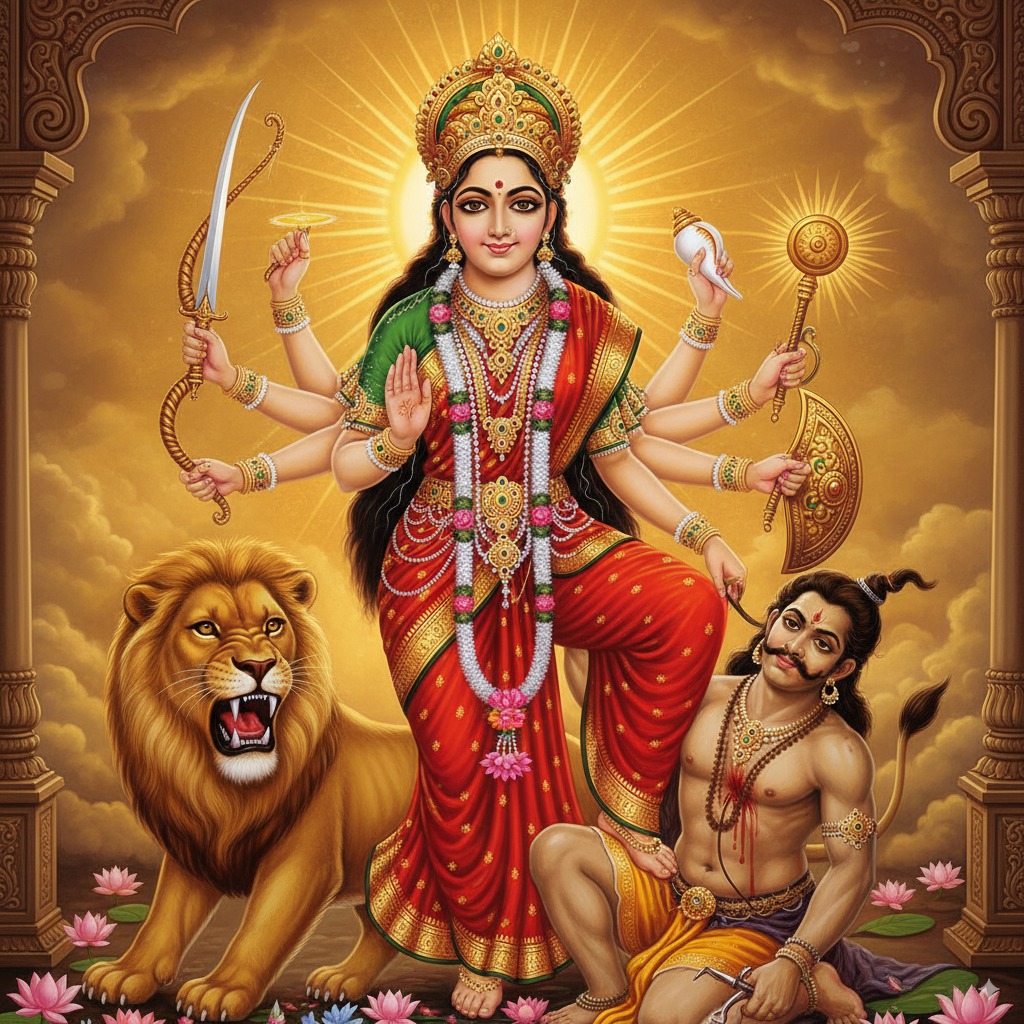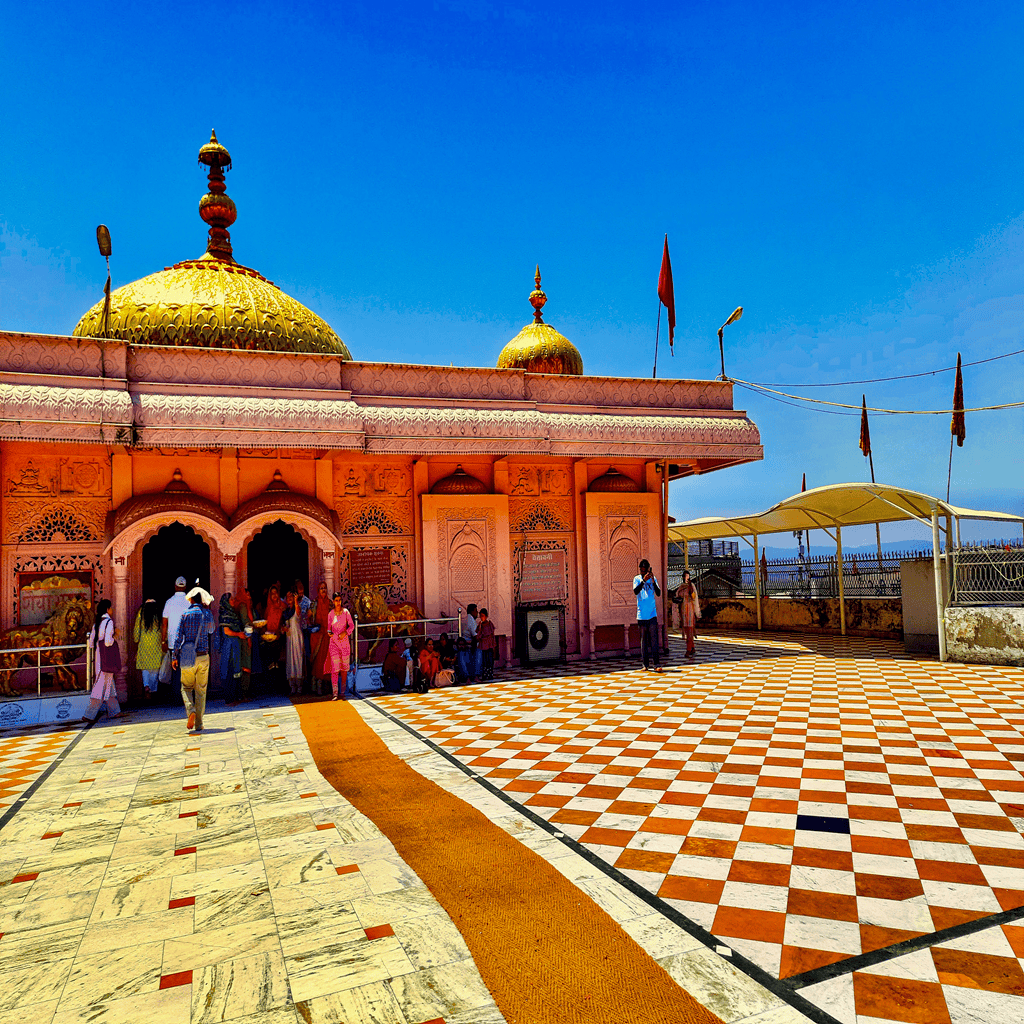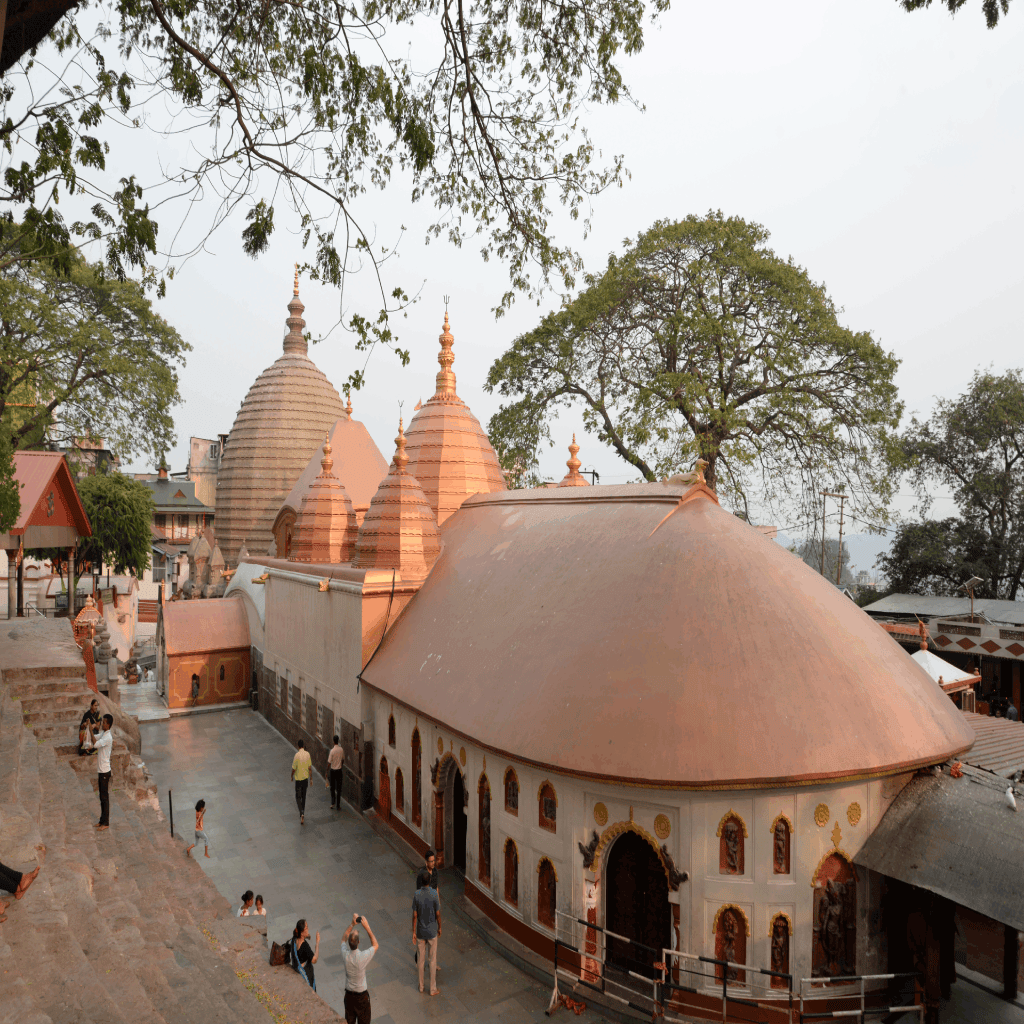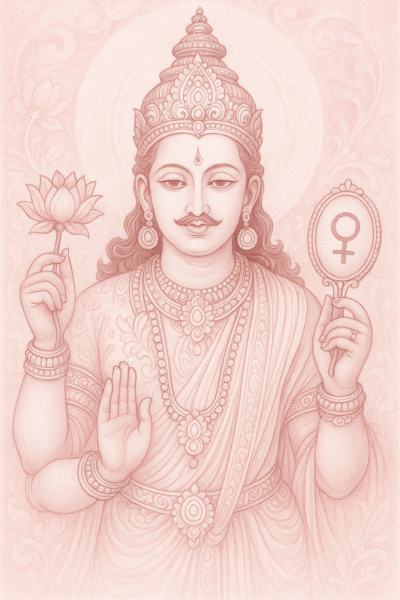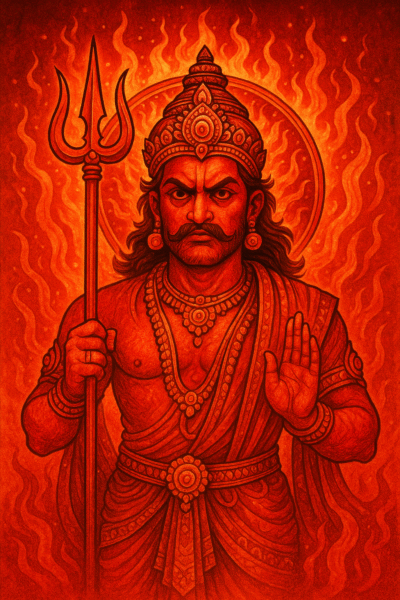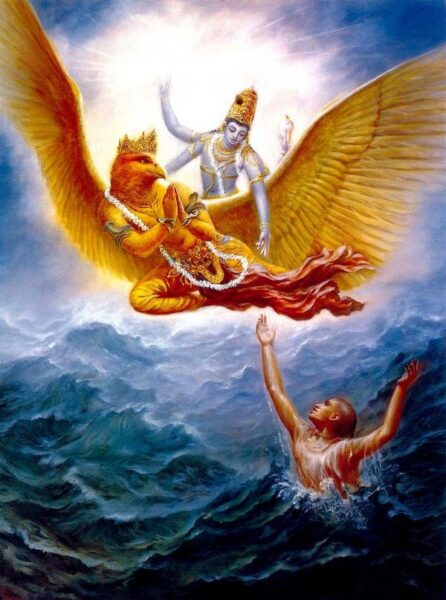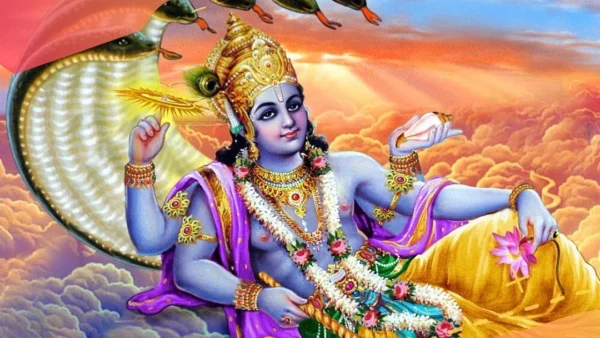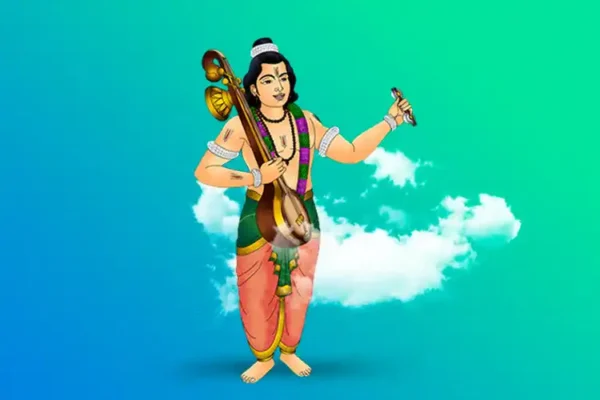Goddess Durga - The Divine Mother and Fierce Protector
Goddess Durga, whose name literally means "the invincible" or "the fort," stands as one of the most powerful and revered deities in Hinduism. She represents the divine feminine energy (Shakti) in its most dynamic and protective form, embodying the universal mother who safeguards her children from all forms of evil and suffering.
Introduction
As the supreme manifestation of Devi (the Divine Goddess), Durga is both nurturing mother and fierce warrior, capable of infinite compassion and devastating power. She is the cosmic force that creates, preserves, and destroys, working in perfect harmony to maintain the balance of the universe. Her worship acknowledges the divine feminine as the ultimate source of all energy and power in creation.
Durga is not merely a deity to be propitiated, but the very essence of Shakti - the primordial cosmic energy that powers all existence. She represents the active, dynamic principle that animates the universe, while her consort Shiva represents the passive, unchanging consciousness. Together, they embody the complete reality of existence.
Physical Attributes & Iconography
The Divine Form
Goddess Durga's magnificent appearance is laden with profound symbolism, each aspect representing cosmic principles and spiritual truths:
Multiple Arms (Usually 8 or 10):
Her many arms represent her ability to simultaneously perform multiple cosmic functions and her omnipresence. Each arm holds a different weapon or symbol, showing her mastery over various aspects of existence.
Weapons and Implements:
- Sword (Kharga): Represents knowledge that cuts through ignorance and illusion
- Trident (Trishul): Symbolizes the three gunas (qualities) and victory over the three worlds
- Bow and Arrow: Signifies energy and the focused mind
- Conch Shell (Shankha): Represents the cosmic sound Om and the call to dharma
- Discus (Chakra): Symbolizes the wheel of time and cosmic order
- Mace (Gada): Represents strength and the power to destroy evil
- Lotus (Padma): Symbolizes purity, potential, and spiritual unfolding
- Bell (Ghanta): Represents the sound that dispels negativity
Physical Features:
- Radiant Complexion: Golden or fair complexion represents purity, divinity, and the illuminating power of consciousness. Some forms show her with a fierce, dark complexion representing the destructive aspect needed to eliminate evil.
- Beautiful Face: Her serene yet determined facial expression shows the perfect balance between compassion and fierce protection. Her eyes burn with divine fury against evil while showing infinite love for devotees.
- Third Eye: When depicted, represents her omniscience and the power of inner vision that sees beyond the material world.
- Crown and Ornaments: Her jeweled crown signifies her supreme sovereignty, while her divine ornaments represent the wealth of spiritual qualities and powers.
- Flowing Hair: Often shown flowing freely, representing the dynamic, untamed nature of divine energy and her freedom from all constraints.
- Red or Golden Garments: Her clothing represents the active, passionate aspect of divine energy working for the welfare of creation.
Divine Vehicle - The Lion
Symbolism of the Lion:
- Courage and Fearlessness: Representing the brave heart needed to fight evil
- Royal Power: Signifying divine authority and sovereignty
- Controlled Passion: The tamed lion shows mastery over base instincts
- Dharmic Strength: The power that supports righteousness
The lion is both her mount and her devotee, showing how divine grace can transform even the most fierce energies into instruments of protection and righteousness.
Sacred Names & Epithets
Durga is known by numerous names, each highlighting different aspects of her divine nature:
- Durgatinashini - Destroyer of difficulties and sufferings
- Mahishasuramardini - Slayer of the buffalo demon Mahishasura
- Bhavani - The giver of life and existence
- Chandika - The fierce, wrathful form
- Ambika - The mother goddess
- Jagadamba - Mother of the universe
- Mahamaya - The great cosmic illusion
- Katyayani - Born from the sage Katyayana's penance
- Kalaratti - The night of time/death
- Shivadooti - Messenger of Shiva
- Bhadrakali - The auspicious fierce form
- Mahakali - The great time/death goddess
- Chamunda - Destroyer of the demons Chanda and Munda
- Skandamata - Mother of Skanda (Kartikeya)
- Kushmanda - Creator of the cosmic egg
- Siddhidatri - Giver of supernatural powers
- Navadurga - The nine forms of Durga
- Shakti - The primordial cosmic energy
- Prakriti - The fundamental nature/matter
Major Legends & Mythology
The Slaying of Mahishasura
The most famous legend of Durga involves her creation and victory over the buffalo demon Mahishasura:
The Demon's Rise:
Mahishasura, through severe penance, obtained a boon that no man or god could kill him. Drunk with power, he conquered the three worlds and defeated the gods.
The Divine Creation:
Unable to defeat Mahishasura individually, all the gods combined their energies to create Goddess Durga. Each god contributed their powers and weapons to her.
The Great Battle:
For nine days and nights, Durga fought the demon and his army. The battle was fierce, with Mahishasura taking various forms to deceive her.
The Victory:
On the tenth day (Vijayadashami), Durga finally slayed Mahishasura, restoring peace to the universe and freeing the gods from his tyranny.
Symbolic Meaning: This represents the victory of divine consciousness over ego, ignorance, and evil tendencies that oppress spiritual growth.
The Origin from Cosmic Energy
According to the Devi Mahatmya, Durga emerged from the combined tejas (radiance) of all the gods when they were threatened by demons:
- Her face came from Shiva's light
- Her arms from Vishnu
- Her feet from Brahma
- Her hair from Yama
- Her breath from Vayu
This shows her as the unified power of all divine forces working together.
The Manifestation as Parvati
Durga is also the active aspect of Parvati, Shiva's consort, representing the divine feminine that can be both gentle mother and fierce protector as the situation demands.
Spiritual Philosophy & Significance
The Divine Feminine Principle
Durga embodies the concept of Shakti - the primordial cosmic energy:
- Creative Power: The force that manifests the universe
- Sustaining Energy: The power that maintains all existence
- Transformative Force: The energy that brings about necessary changes
- Protective Mother: The nurturing aspect that cares for all creation
The Balance of Compassion and Strength
Durga teaches the importance of balancing different aspects of power:
- Gentle with devotees, fierce with evil: Showing appropriate response
- Protective but not overprotective: Allowing growth through challenges
- Strong but not cruel: Using power responsibly and with discrimination
- Independent yet relational: Self-sufficient but caring for others
The Empowerment of the Individual
Durga's worship empowers devotees by:
- Building inner strength: Developing courage to face difficulties
- Removing fears: Providing confidence through divine protection
- Enhancing determination: Inspiring perseverance in righteous causes
- Awakening inner power: Helping realize one's own divine nature
Major Festivals & Celebrations
Navaratri (The Nine Nights)
Timing: Celebrated twice yearly - Chaitra (spring) and Ashwin (autumn)
Duration: Nine nights and ten days
Significance: Celebrates Durga's victory over Mahishasura
Observances:
- Fasting: Various levels from complete fasts to specific dietary restrictions
- Dancing: Garba and Dandiya Raas in Gujarat, other regional dances
- Prayers: Continuous chanting, recitation of Durga Saptashati
- Decorations: Elaborate pandals (temporary structures) and home decorations
- Community Gatherings: Bringing people together in celebration
Regional Variations:
- Bengal: Durga Puja with elaborate artistic pandals
- Gujarat: Garba and Dandiya with vibrant costumes
- Tamil Nadu: Golu displays with dolls and decorations
- Karnataka: Mysore Dasara with royal processions
Durga Puja (Bengal)
Significance: Most elaborate celebration of Durga, especially in Bengal
Duration: Five days culminating in Vijayadashami
Features:
- Artistic Pandals: Temporary temples with stunning decorations
- Cultural Programs: Music, dance, drama, and literary events
- Community Bonding: Bringing together people from all backgrounds
- Artistic Expression: Platform for artists, craftspeople, and performers
Vijayadashami/Dussehra
Date: Tenth day of Navaratri
Significance: Celebrates Durga's victory and Rama's victory over Ravana
Observances:
- Weapon Worship: Honoring tools and instruments of work
- New Beginnings: Starting new ventures and learning
- Victory Celebrations: Processions and community festivities
Chaitra Navaratri
Timing: Spring season (March-April)
Significance: Beginning of the Hindu New Year in many regions
Special Features:
- New Beginnings: Planting seeds, starting projects
- Renewal: Physical and spiritual cleansing practices
- Nature Connection: Celebrating the spring season
Sacred Texts & Literature
Durga Saptashati (Devi Mahatmya)
- Content: 700 verses describing Durga's victories over various demons
- Significance: Most important text for Durga worship
- Structure: Three major stories of divine intervention
- Benefits: Regular recitation brings protection and spiritual growth
Durga Chalisa
- Format: Forty verses praising Durga's qualities and deeds
- Purpose: Daily worship and meditation
- Benefits: Building devotion and receiving divine grace
Durga Suktam
- Source: Vedic hymns dedicated to divine feminine energy
- Significance: Ancient recognition of the goddess principle
- Use: Ritual worship and meditation
Regional Literature
- Bengali: Extensive devotional poetry and songs
- Tamil: Compositions by saint-poets
- Sanskrit: Classical stotras and hymns
- Hindi: Devotional songs and prayers
Worship Practices & Rituals
Daily Worship (Nitya Puja)
Morning Rituals:
- Meditation: Contemplating Durga's divine form
- Mantra Chanting: Reciting sacred names and prayers
- Offering: Flowers, incense, light, and food
- Reading: Portions from Durga Saptashati or other texts
- Prayer: Personal communication with the goddess
Evening Worship:
- Aarti: Waving lights before the deity's image
- Bhajan: Devotional singing
- Meditation: Reflecting on the day's events with divine consciousness
- Gratitude: Thanking the goddess for protection and blessings
Special Observances
Navaratri Worship:
- Kalasha Sthapana: Establishing the sacred pot
- Daily Pujas: Specific rituals for each of the nine days
- Fasting: Various levels of dietary discipline
- Scripture Reading: Daily portions of sacred texts
- Community Participation: Joining group celebrations
Durga Puja (Bengal Style):
- Bodhon: Awakening the goddess
- Adhivas: Ceremonial invocation
- Daily Ritual: Elaborate pujas with specific procedures
- Ashtami: Most important day with special ceremonies
- Visarjan: Immersion of the deity's image
Sacred Offerings
Traditional Items:
- Flowers: Red roses, marigolds, lotus, jasmine
- Foods: Sweets, fruits, rice preparations, traditional dishes
- Colors: Red sindoor, turmeric, sandalwood paste
- Lights: Oil lamps, incense, camphor
- Cloth: Red or yellow garments and scarves
Special Preparations:
- Halwa: Sweet preparations offered with devotion
- Kheer: Rice pudding prepared as offering
- Fruits: Seasonal fruits arranged beautifully
- Panchamrita: Mixture of five sacred substances
Sacred Mantras & Prayers
Durga Gayatri Mantra
Om Girijayai Cha Vidmahe Shivapriayai Cha Dhimahi Tanno Durga Prachodayat
This mantra invokes Durga's blessings for wisdom and protection.
Durga Beej Mantra
Dum Durgayei Namaha
A powerful seed mantra for quick connection with Durga's energy.
Sarva Mangala Mantra
Sarva Mangala Mangalye Shive Sarvartha Sadhike Sharanye Tryambake Gauri Narayani Namostute
Invoking Durga as the source of all auspiciousness and the fulfiller of all desires.
Mahishasura Mardini Stotra
Purpose: Elaborate hymn describing Durga's victory over Mahishasura
Benefits: Protection from enemies and negative forces
Usage: Recited during Navaratri and for overcoming difficulties
Ya Devi Sarva Bhuteshu
Ya Devi Sarva Bhuteshu Shakti Rupena Samsthita Ya Devi Sarva Bhuteshu Matra Rupena Samsthita Namastasyai Namastasyai Namastasyai Namo Namaha
Recognizing the goddess as present in all beings in various forms.
Benefits of Durga Devotion
Spiritual Benefits
Inner Strength and Courage:
- Development of fearlessness in spiritual practice
- Ability to face life's challenges with equanimity
- Strength to overcome negative tendencies and habits
- Courage to stand up for truth and righteousness
Protection and Purification:
- Shield from negative energies and evil influences
- Purification of consciousness and removal of sins
- Protection during spiritual practices and meditation
- Cleansing of karmic debts and obstacles
Divine Grace and Empowerment:
- Direct connection with the divine feminine energy
- Awakening of inner spiritual powers and abilities
- Grace to progress rapidly on the spiritual path
- Ultimate liberation through divine mother's blessings
Material Benefits
Protection from Dangers:
- Safety from accidents, natural disasters, and violence
- Protection from enemies, litigation, and conflicts
- Shield from diseases, epidemics, and health problems
- Security for family members and loved ones
Success and Prosperity:
- Success in career, business, and material endeavors
- Removal of obstacles preventing progress
- Fulfillment of legitimate desires and goals
- Prosperity and abundance in all aspects of life
Family Harmony:
- Peace and happiness in domestic life
- Protection and welfare of children
- Harmonious relationships within the family
- Blessings for marriage and marital happiness
Psychological Benefits
Confidence and Self-Esteem:
- Building unshakeable confidence in oneself
- Overcoming fears, phobias, and anxieties
- Developing healthy self-esteem and self-respect
- Ability to handle criticism and opposition
Emotional Balance:
- Control over anger, jealousy, and negative emotions
- Development of patience, tolerance, and understanding
- Emotional stability during difficult periods
- Joy and contentment in daily life
Mental Clarity:
- Sharp intellect and clear decision-making ability
- Discrimination between right and wrong
- Focus and concentration in all activities
- Freedom from confusion and mental disturbances
Durga in Modern Context
Feminine Empowerment
Durga serves as a powerful symbol for:
- Women's Rights: Inspiration for gender equality and women's empowerment
- Leadership: Model of strong, compassionate leadership
- Independence: Example of self-reliance while maintaining relationships
- Balance: Integration of strength with nurturing qualities
Environmental Consciousness
Durga's connection with nature teaches:
- Respect for Earth: The goddess as mother nature
- Sustainable Living: Harmony with natural cycles
- Conservation: Protection of natural resources
- Ecological Balance: Maintaining harmony in ecosystems
Social Justice
Durga's role as protector inspires:
- Fighting Injustice: Standing up against oppression and corruption
- Protecting the Vulnerable: Caring for those who cannot protect themselves
- Community Service: Using strength to serve society
- Righteous Action: Acting with courage for the greater good
Global Relevance
Durga worship has spread globally, offering:
- Universal Motherhood: Recognition of divine feminine in all cultures
- Strength in Diversity: Celebrating different forms of divine expression
- Community Building: Bringing people together across cultural boundaries
- Spiritual Healing: Providing comfort and strength to global devotees
Durga in Art & Culture
Traditional Arts
- Sculpture: Magnificent temple carvings and bronze statues
- Painting: Classical and folk art depicting various forms
- Dance: Classical dance forms portraying Durga's stories
- Music: Devotional songs and classical compositions
Contemporary Expression
- Literature: Modern poetry and stories inspired by Durga
- Cinema: Films exploring themes of feminine power and protection
- Theatre: Dramatic presentations of Durga's legends
- Digital Art: Modern interpretations using contemporary media
Festival Arts
- Pandal Art: Temporary architectural marvels during festivals
- Craft Traditions: Regional handicrafts associated with worship
- Performance Arts: Cultural programs during celebrations
- Community Participation: Involving people in artistic expression
Conclusion
Goddess Durga represents the perfect embodiment of divine feminine energy — protective, nurturing, powerful, and compassionate. Her worship offers a complete path for spiritual development while providing practical guidance for living with strength and grace in the modern world.
Through devotion to Durga, one learns to balance gentleness with firmness, compassion with discrimination, and love with the courage to protect what is sacred. She teaches that true strength comes not from aggression but from righteousness, and that the greatest power is that which serves the highest good of all.
Durga's message is particularly relevant in contemporary times when the world needs the healing touch of the divine mother combined with the fierce protection against forces that threaten peace and harmony. Her worship awakens the dormant spiritual power within every individual while fostering a deep connection with the creative, sustaining, and transformative energies of the universe.
Whether approached as the protective mother, the fierce warrior against evil, or the supreme goddess who grants all boons to sincere devotees, Durga responds with infinite love and power to those who seek her with pure hearts. Her grace transforms ordinary individuals into instruments of divine will, working for the establishment of righteousness and the welfare of all beings.
In surrendering to Durga, devotees find not only personal protection and empowerment but also the opportunity to participate in the cosmic work of maintaining dharma and protecting the innocent. Her blessings extend beyond individual benefit to encompass the welfare of family, community, and the entire world.
Om Dum Durgayei Namaha - I offer my respectful obeisances to Goddess Durga, the invincible protector and supreme divine mother who grants fearlessness and ultimate liberation to all who surrender to her lotus feet.

